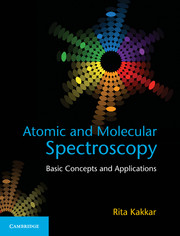Book contents
- Frontmatter
- Dedication
- Contents
- List of Figures
- List of Tables
- Preface
- Acknowledgements
- List of Abbreviations
- 1 Fundamentals of Spectroscopy
- 2 Theoretical Principles
- 3 Atomic Spectroscopy
- 4 Pure Rotational Spectroscopy
- 5 Vibrational Spectroscopy of Diatomics
- 6 Vibrational Spectroscopy of Polyatomic Molecules
- 7 The Raman Effect
- 8 Electronic Spectroscopy of Diatomic Molecules
- 9 Electronic Spectroscopy of Polyatomic Molecules
- Appendix 1 THE SPECTRUM OF THE NON-RIGID ROTATOR
- Appendix 2 CHARACTER TABLES OF SOME IMPORTANT SYMMETRY GROUPS
- References
- Index
7 - The Raman Effect
Published online by Cambridge University Press: 05 June 2015
- Frontmatter
- Dedication
- Contents
- List of Figures
- List of Tables
- Preface
- Acknowledgements
- List of Abbreviations
- 1 Fundamentals of Spectroscopy
- 2 Theoretical Principles
- 3 Atomic Spectroscopy
- 4 Pure Rotational Spectroscopy
- 5 Vibrational Spectroscopy of Diatomics
- 6 Vibrational Spectroscopy of Polyatomic Molecules
- 7 The Raman Effect
- 8 Electronic Spectroscopy of Diatomic Molecules
- 9 Electronic Spectroscopy of Polyatomic Molecules
- Appendix 1 THE SPECTRUM OF THE NON-RIGID ROTATOR
- Appendix 2 CHARACTER TABLES OF SOME IMPORTANT SYMMETRY GROUPS
- References
- Index
Summary
Comparing to Compton Effect, “Ah, but my effect will play a great role for chemistry and molecular structure!”
—Sir C. V. RamanINTRODUCTION
We now move on to the next topic, i.e., Raman spectroscopy, discovered in 1928 by the great Indian physicist, Sir C. V. Raman, who was awarded the Nobel Prize in 1930 ‘for his work on the scattering of light and for the discovery of the effect named after him’. All the spectroscopies studied so far were based on the absorption of light. In contrast, Raman spectroscopy is based on scattering of light. Hence, the Bohr condition is not required for observing the Raman effect.
When a molecule is illuminated by visible or ultraviolet radiation, it gets excited to a virtual state from which it may drop to the same, lower or higher energy level. If it drops to the same energy level, the scattered radiation has the same frequency as the incident radiation (elastic scattering), and this is called Rayleigh scattering, responsible for the blue colour of the sky and the red colour of sunset. Lord Rayleigh showed that the intensity of the scattered radiation is inversely proportional to the fourth power of the wavelength, i.e., IRayleigh ∝ 1/λ4, so blue light (shorter wavelength) is scattered more than red light (longer wavelength). When we view sunset through several layers of the atmosphere, what we observe is red light, because the blue part of the visible (white) light is scattered away sideways.
Alternatively, the molecule may drop to a higher energy with absorption of energy from the incident radiation, leaving the scattered light at lower energy (inelastic scattering) and it is then observed at lower wavenumber. Such scattering is called Stokes scattering. In case the molecule is already in an excited internal energy level, it may return to the ground state, and in that case the scattered radiation will be at higher wavenumber than the incident radiation. This kind of scattering is known as anti-Stokes scattering, and collectively Stokes and anti-Stokes scattering account for Raman scattering (Figure 7.1).
- Type
- Chapter
- Information
- Atomic and Molecular SpectroscopyBasic Concepts and Applications, pp. 263 - 304Publisher: Cambridge University PressPrint publication year: 2015



